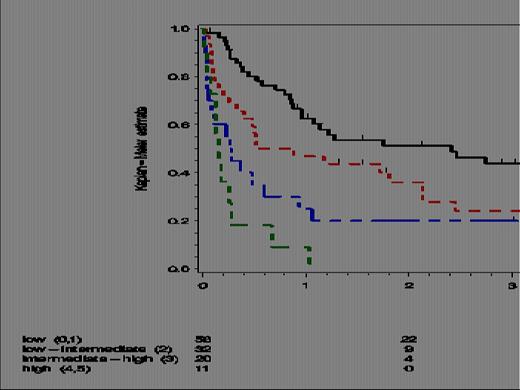Abstract

Approximately 2-8% chronic lymphocytic leukemia (CLL) patients develop diffuse large B-cell lymphoma (DLBCL, so-called Richter syndrome [RS]) over long-term follow-up. The outcomes of patients with RS are variable and poorly understood.
CLL patients seen at Mayo Clinic from January 1995 to April 2013 who developed biopsy-proven DLBCL during follow-up were included in this analysis. Clinical characteristics, therapy and overall survival (OS) of all patients with RS were analyzed.
One hundred and twenty patients with biopsy-proven RS were identified in the Mayo Clinic database. The median age at diagnosis of RS was 67 years (range, 29-88 years), 87 (73%) were male, and 83 (69%) had received prior CLL therapy. The median duration between diagnosis of CLL and development of RS was 3.8 years (range, 0-34.5 years). Stereotyped B-cell receptors were found in 9/30 (30%) RS patients compared to 219/1294 (17%) non-RS patients (OR=2.1, p=0.07). IGHV4-39 gene usage was present in 2/26 (8%) RS patients compared to 57/1354 (4%) non-RS patients (p=0.3). Of the 30 RS biopsy samples in which Epstein Barr virus (EBV) in-situ hybridization studies were performed, EBV was detected in 7 (23%) patients.
After a median follow-up of 5.2 years, 86 (72%) patients have died. Causes of death were as follows: progressive DLBCL (n=46, 53%), progressive CLL (n=2, 2%), infection (n=8, 9%), unknown (n=20, 23%) and other (n=10, 12%). The median OS of the entire cohort was 0.9 years (95% CI, 0.5-1.3 years). Tsimberidou and colleagues proposed a prognosis score (RS score) based on the following variables at the time of RS diagnosis: Eastern Co-operative Group performance status of 2-4, lactate dehydrogenase >1.5 x normal, platelets<100 x 109/L, tumour size >5 cm and >1 prior therapy for CLL. Each parameter was assigned one point, and patients were then assigned to one of four risk groups based on their calculated RS score: 0 or 1, low risk; 2, low-intermediate risk; 3, high-intermediate risk; 4 or 5, high risk. The OS according to the RS score for our group of patients is shown in Figure 1. Median survival in the low, intermediate-1, intermediate-2 and high-risk groups were 2.4 years, 0.7 years, 0.3 years and 0.2 years, respectively (p<0.001).
Fifteen (12%) patients received cyclophosphamide, doxorubicin, vincristine and prednisone (CHOP) as initial therapy for RS, and 68 (57%) received rituximab in addition to CHOP (R-CHOP). There was no difference in survival among patients who received CHOP compared to R-CHOP (median, 1.8 years. vs. 1.2 years, p=0.5). Twenty-four patients (20%) received non-CHOP-based chemotherapy, and treatment was unknown in 4 (3%) patients. Nine patients (7%) died before definitive therapy could be instituted.
Thirteen (11%) patients were able to proceed to stem cell transplantation (SCT): 10 (8%) autologous SCT, 2 (2%) allogeneic SCT and 1 (1%) autologous SCT followed by an allogeneic SCT. Although RS patients who underwent SCT were younger compared to those who did not undergo SCT (median, 59 years. vs. 69 years, p=0.001), no differences in prior CLL therapy or receipt of R-CHOP therapy for DLBCL was noted between the two groups. The median survival of patients who proceeded to SCT was superior compared to those who did not (5.2 years vs. 0.7 years; p=0.005).
Stereotyped B-cell receptors but not VH4-39 had a suggested evidence of an increased risk of RS in our cohort. Although 90% RS patients received intensive chemotherapy, only 11% patients were able to proceed to SCT. Median survival of RS patients remains dismal at 1 year, and newer therapies are needed to improve outcomes.
Shanafelt:Genentech: Research Funding; Glaxo-Smith-Kline: Research Funding; Cephalon: Research Funding; Hospira: Research Funding; Celgene: Research Funding; Polyphenon E International: Research Funding.
Author notes
Asterisk with author names denotes non-ASH members.

This icon denotes a clinically relevant abstract


This feature is available to Subscribers Only
Sign In or Create an Account Close Modal